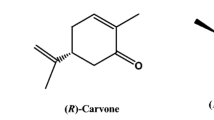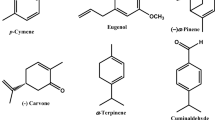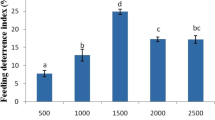Abstract
Monoterpenes, phenylpropenes and sesquiterpenes are the major constituents of essential oils of many aromatic plants and possess a wide spectrum of biological activities. In this study, the effect of eleven monoterpenes, phenylpropenes and sesquiterpenes on larval and pupal duration, pupation, pupal weight, adult emergence, fecundity and fertility of Spodoptera littoralis were evaluated. Results showed that larvae fed on the treated diet at 500, 1000 and 2000 mg/kg developed slower than those fed on untreated diet. trans- Cinnamaldehyde (500 mg/kg) was the most effective compound in increasing larval duration of 20.4 days compared to 13.5 days in control, followed by1,8-cineole and ( −)-citronellal. Also, treatment with ( −)-carvone, ( −)-citronellal, eugenol, p-cymene and α-pinene prolonged pupal duration by 1 to 3 days compared to control. On the other hand, the tested compounds significantly reduced pupation percentage and pupal weight of S. littoralis. trans-Cinnamaldehyde was more effective than a reference insect growth regulator, pyriproxyfen, in pupation percent reduction at 500 mg/kg. Furthermore, the tested compounds strongly decreased adult emergence of S. littoralis with 1,8-cineole being the most effective compound as it lowered adult emergence to 23.3, 16.7, and 13.3% at 500, 1000, and 2000 mg/kg, respectively, compared to 90.0% in control. In addition, oviposition and eclosion were significantly reduced by the tested compounds. trans-Cinnamaldehyde, ( −)-citronellal, 1,8-cineole, ( −)-carvone and (Z,E)-nerolidol were the most effective compounds on oviposition and egg hatching reduction.

Similar content being viewed by others
References
Abdelgaleil SAM, El-Aswad AF (2005) Antifeedant and growth inhibitory effects of tetranortriterpenoids isolated from three meliaceous species on the cotton leafworm, Spodoptera littoralis (Boisd.). Res J Appl Sci 1:234–241
Abdelgaleil SAM, Mohamed MIE, Badawy MEI, El-arami SAA (2009) Fumigant and contact toxicities of monoterpenes to Sitophilus oryzae (L.) and Tribolium castaneum (Herbst) and their inhibitory effects on acetylcholinesterase activity. J Chem Ecol 35:225–232
Akhtar Y, Pages E, Stevens A, Bradbury R, daCamara CAG, Isman MB (2012) Effect of chemical complexity of essential oilson feeding deterrence in larvae of the cabbage looper. Physiol Entomol 37:81–91
Campli ED, Soraya Di Bartolomeo SD, Pizzi PD, Giulio MD, Grande R, Nostro A, Cellini L (2012) Activity of tea tree oil and (Z, E)-nerolidol alone or in combination against Pediculus capitis (head lice) and its eggs. Parasitol Res 111:1985–1992
Chaubey MK (2012) Acute, lethal and synergistic effects of some terpenes against Tribolium castaneum Herbst (Coleoptera: Tenebrionidae). Ecol Balk 4:53–62
Copping LG, Duke SO (2007) Natural products that have been used commercially as crop protection agents. Pest Manag Sci 63:524–554
Duke SO, Cantrell CL, Meepagala KM, Wedge DE, Labanca N, Schräder KK (2010) Natural toxins for use in pest management. Toxins 2:1943–1962
El-Arami SAA, Mohamed MIE, Abdelgaleil SAM (2009) Effectiveness of monoterpenes against Sitophilus oryzae (L.) and Tribolium castaneum (Herbst) in stored wheat. J Pest Cont Environ Sci 17:61–76
EL-Defrawi ME, Tappozada A, Mansour N, Zeid M, (1964) Toxicological studies on the Egyptian cotton leafworm Prodenia litura L.: Susceptibility of different larval instars of Prodenia to insecticides. J Econ Entomol 57:591–593
Fischer NH, Williamson GB, Weidenhamer JD, Richardson DR (1994) In search of allelopathy in the Florida scrub: The role of terpenoids. J Chem Ecol 20:1355–1379
Hernández-Carlos B, Gamboa-Angulo M (2019) Insecticidal and nematicidal contributions of Mexican flora in the search for safer biopesticides. Molecules 24:897–940
Isman MB, Miresmailli S, Machial C (2011) Commercial opportunities for pesticides based on plant essential oils in agriculture, industry and consumer products. Phytochemistry Rev 10:197–204
Langenheim JH (1994) Higher plant terpenoids: a phytocentric overview of their ecological roles. J Chem Ecol 20:1223–1280
Lee S, Tsao R, Coats JR (1999) Influence of dietary applied monoterpenoids and derivatives on survival and growth of the European corn borer (Lepidoptera: Pyralidae). J Econ Entomol 92:56–67
Miresmailli S, Isman MB (2014) Botanical insecticides inspired by plant-herbivore chemical interactions. Trends Plant Sci 19:29–35
Pavela R (2016) History, presence and perspective of using plant extracts as commercial botanical insecticides and farm products for protection against insects – a review. Plant Protect Sci 52:229–241
Peixoto MG, Bacci L, Blank AF, Araújo APA, Alves PB, Silva JHS, Santos AA, Oliveira AP, da Costa AS, Arrigoni-Blank MF (2015) Toxicity and repellency of essential oils of Lippia alba chemotypes and their major monoterpenes against stored grain insects. Ind Crops Prod 71:31–36
Raffa KF (1987) Influence of host plant on deterrence by azadirachtinof feeding by fall army worm larvae. J Econ Entomol 80:384–387
Rajkumar V, Gunasekaran C, Christy IK, Dharmaraj J, Chinnaraj P, Paul CA (2019) Toxicity, antifeedant and biochemical efficacy of Mentha piperita L. essential oil and their major constituents against stored grain pest. Pestic Biochem Physiol 156:138–144
Saad MMG, Abou-Taleb HK, Abdelgaleil SAM (2018) Insecticidal activity of monoterpenes and phenylpropenes against Sitophilus oryzae L. and their acetylcholinesterase and adenosine triphosphatases inhibitory effects. Appl Entomol Zool 53:173–181
Saad MMG, Abdelgaleil SAM, Suganuma T (2012) Herbicidal potential of pseudoguaninolide sesquiterpenes on wild oat, Avena fatua L. Biochem Syst Ecol 44:333–337
Silva JF, Melo BA, Pessoa EB, Neto AF, Leite DT (2013) Plant extracts for the control the bean weevil Zabrotes subfasciatus (Boheman 1833) (Coleoptera: Bruchidae). Revista Verde 8:1–5
Singh JP, Marwaha KK (2000) Effect of sublethal concnetrations of some insecticides on growth and development of maize stalk borer, Chilo partellus (Swinhoe) larvae. Shashpa 7:181–186
Stamopoulos DC, Damos P, Karagianidou G (2007) Bioactivity of five monoterpenoid vapours to Tribolium confusum (du Val) (Coleoptera: Tenebrionidae). J Stored Prod Res 43:571–577
Szczepanik M, Gliszczynska A, Hnatejko M, Zawitowska B (2016) Effects of halolactones with strong feeding-deterrent activity on the growth and development of larvae of the lesser mealworm, Alphitobius diaperinus (Coleoptera: Tenebrionidae). Appl Entomol Zool 51:393–401
Zahran HA, Abdelgaleil SAM (2011) Insecticidal and developmental inhibitory properties of monoterpenes on Culex pipiens L. (Diptera: Culicidae). J Asia Pac Entomol 14:46–51
Zebitz CPW (1986) Effect of three different neem kernel extracts and azadirachtin on larvae of different mosquito species. J Appl Entomol 102:455–463
Zou J, Cates RG (1997) Effects of terpenes and phenolic and flavonoid glycosides from Douglas fir on western spruce budworm larval growth, pupal weight, and adult weight. J Chem Ecol 23:2313–2326
Acknowledgments
This work was partially supported by the Alexandria University Research Fund (ALEX-REP).
Author information
Authors and Affiliations
Corresponding author
Ethics declarations
Conflict of interest
The authors declare that they have no conflict of interest.
Additional information
Publisher's Note
Springer Nature remains neutral with regard to jurisdictional claims in published maps and institutional affiliations.
Rights and permissions
About this article
Cite this article
Abdelgaleil, S.A.M., Al-Nagar, N.M.A., Abou-Taleb, H.K. et al. Effect of monoterpenes, phenylpropenes and sesquiterpenes on development, fecundity and fertility of Spodoptera littoralis (Boisduval). Int J Trop Insect Sci 42, 245–253 (2022). https://doi.org/10.1007/s42690-021-00539-y
Received:
Accepted:
Published:
Issue Date:
DOI: https://doi.org/10.1007/s42690-021-00539-y




